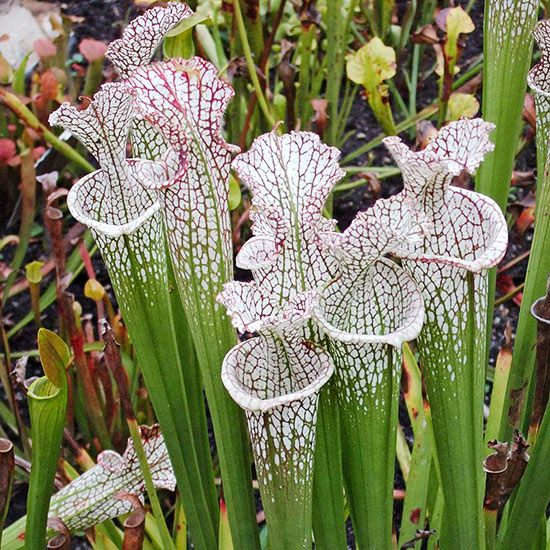






If ever a plant had looks that were deceiving, it is the pitcher plant. Exotic in appearance, these plants have proven themselves to be amazingly adaptive to less-than-ideal growing situations. Whether you're intrigued by their distinctive beauty or simply looking for an out-of-the-ordinary plant to add to your garden, here's a comprehensive list of pitcher plant facts.
Pitcher Plant Basics
Sandy soils that are deficient in essential nutrients may seem incompatible with any plant, but that's where pitcher plants got their start. "They were stuck in dry sand and modified their leaves into a pitcher," says Tony Avent with Plant Delights Nursery in Raleigh, North Carolina.
Inside that pitcher, Avent says, are some good-smelling compounds. When those substances mix with water, they attract insects. This is where the idea of a "carniverous pitcher plant" comes in -- insects crawl in, slip down the slick insides, fall in, drown, and dissolve. The plant then uses the insects as fertilizer. "It's very clever on the plant's part; they really made lemonade out of lemons."
Early plant explorers were convinced pitcher plants came from Mars because they are so out-of-this-world, Avent says. "Pitcher plants are one of the ultimate examples of adaptation," he says. "Along with their counterpart, the Venus flytrap, they're the things of great stories and great movies like Little Shop of Horrors."
Learn how to care for a Venus flytrap.
Pitcher plants are native from Canada all the way down to Florida and across Texas; a separate genus is found in Canada and a third on the West Coast. "They grow in areas that can be seasonally flooded but don't stay flooded for very long," Avent says.
How to Grow Pitcher Plants
How pitcher plants evolved also provides clues about how they can best be grown. "A common mistake that people make is to keep them too wet," Avent says. "If they are soggy, they will die."
What they like, he says, are wet toes, dry ankles, and full sun. Avent recommends planting them in pure peat moss, whether in containers or the ground, and never fertilizing them. "They like the water, but they like it down about 6 inches, with the top dry," he says. "And if you put them in shade, they will go downhill."
Pitcher Plant Bloom Guide
Before the pitchers emerge, the plants also produce white, pink, red, or yellow blooms beginning in April and continuing through May. Varieties that have a white-topped pitcher plant as a parent also produce blooms in the fall. As much as the pitchers put on a show, the flowers are, Avent says, "bizarre." "The rides at a fair that hang you in this little cart and twirl you upside-down: The pitcher plant flowers look like that," he says.
How to Use Pitcher Plants in Gardens and Containers
Breeders continue to produce more and more new varieties each year, Avent says. In Europe, they're highly prized as cut flowers. While people often think of tropical pitcher plants, in the garden, they can be used in climates to Zone 4, Avent says.
When used in containers, Avent suggests placing a dish of water underneath to keep those toes wet. If grown in containers, they need time to hibernate. "If they don't, they come back up and they're in a really bad mood and they'll waste away," he says.
That means in wintertime the plants have to be chilled below 40 degrees F, but no cooler than 25 below 0 degrees F, for a couple of months; then they can be brought back inside to enjoy. The chill gives the plant time to rest but keeps the roots from freezing.
In addition, resist the temptation to dump lots of insects in the plants. "If the leaf, or pitcher, fills up, it won't be able to photosynthesize," Avent says. "Pitcher plants really do thrive on neglect."
Probably because of its peculiar beauty, they are an amusement for kids, too. "Kids like weird things, and it's a great tool to get kids interested in gardening," Avent says.
See different varieties of pitcher plants in our Plant Encyclopedia.
Learn about other carnivorous plants.
Learn about insect-eating plants you can grow indoors.
Copyright © www.100flowers.win Botanic Garden All Rights Reserved